Integration Blueprint
Project Management
Your recipe for creating an integration HubSpot users want.
Customer Use Case
Heather is the SVP of Strategy at Rocket Inc, a fast growing SaaS company in California. She manages a team of 30 Analyst & Researchers & 10 Project Managers, who work cross-functionally across the company. Their company adopted HubSpot & a new project management software 9 months ago to manage all their projects & initiatives; their entire team primarily works in their Project Management software. One of their collaboration teams, Partnerships, needs insight into how partner projects are going without leaving HubSpot. Her team needs insight into many aspects of how the business is operating, to track progress & make future decisions.
Integrating your Project Management tool with HubSpot helps our common users have a more complete picture. Sales reps can see how a customer’s project is going after their deal has closed while Customer Success reps who received the project as soon as the customer closes can be alerted when a ticket is opened. Support reps can see customer projects along with CRM data when solving for the customer. Project Managers can see deal data to improve resource planning and capacity management.
Who uses a Project Management Integration?

Sales
- Provides a window in customer projects post close
- keep customer data updated post close
Customer Success
- Projects are kicked off in PM tool automatically
- Pre sales data flows into PM to provide additional context when a customer opens a ticket with a HubSpot rep, the CS rep has insights into it.
Support
- The PM integration provides a window into customer's projects to support the rep.
Project Managers
- Better insights into upcoming and current projects for resource management and timeline expectations
API Recommendations
OAuth 2.0
Customer value
OAuth allows secure authorization from the customer to share their information with the integration. This improves security and user experience as the customer does not have to manage multiple sets of login information for each integration they use.

Custom Workflow Actions
Customer value
Custom Workflow Actions will allow customers to automate processes between their Flywheel teams: Marketing, Sales, and Customer Service.
Use cases
- Automate project creation in PM tool based on an action in HubSpot
- Ex. Create a Project or Task in the PM tool when a deal closes in HubSpot
- Log product issues or bug automatically when a customer files a ticket.
- Reducing manual data transfers between systems minimizes errors and saves time, leading to more efficient operations and better project outcomes.
➜ Recommended to be used on the Deal, Contact, Company, or Ticket object

UI Extensions
Customer value
Allows the sales and service teams to have insight into how customer projects are going. Reps can interact with third party tools all without leaving the HubSpot UI saving time and context switching.
Use cases
- Pull project status into the CRM card so the sales and service teams can get a 360° view on tasks and projects inside HubSpot.
- This eliminates the need for sales teams to have manual updates from Project Management teams.
- Create / update tasks and projects directly from inside HubSpot.
- Project Managers can see important project info from deal closing.
- Prepare for a meeting equipped with relevant previous project or recent project status.

Timeline Events
Customer value
Enrich customer profiles by capturing and displaying all actions and interactions within a single, chronological view. This feature enhances understanding of customer behavior and journey, enabling businesses to tailor their strategies and communications more effectively. By leveraging detailed insights from timeline events, companies can anticipate needs, personalize outreach, and build deeper, more meaningful relationships with their customers.
➜ Recommended to be used on the Company & Deal objects

Webhooks
Customer value
Subscribe to events happening in a Hubspot account with your integration installed. Webhooks can be more scalable than regularly polling for data changes, especially for apps with a large install base.
Webhooks allow developers to receive real-time updates and notifications, improving their overall experience and efficiency.
➜ Recommended to use Contact, Company, Deal Objects.
➜ Recommended to use Created, Deleted, Properties Changed subscriptions.

CRM Properties
Customer value
Syncing data two-ways enables users to easily organize and store customer data in HubSpot as the central location, making it easier to quickly access and use relevant data. Having data accurate and up-to-date is key for efficiency and scale.
➜ Recommended to use CRM Properties API to create & read properties on the Contact, Company, Deal, & Ticket objects.

Contacts
Customer value
Contacts store information about the individual people a user interactions with. The ‘contacts’ endpoint allows users to create and manage contact records in their HubSpot account, as well as sync contact data between HubSpot and your app.
Contacts can be assigned to many areas within a users HubSpot account, including being assigned as the person responsible for Companies, Deals, Tickets, and much more.
➜ Read, create, and update Contacts using Contacts API.

Companies
Customer value
Companies store information about organizations that interact with their business. The ‘companies’ endpoints allow you to manage and create company records, as well as sync company data between HubSpot and your app.
➜ Read, create, and update Company using Companies API.

Deals
Customer value
Deals represent transactions with contacts or companies. The ‘deals’ endpoints allow you to manage create and manage deal records, as well as sync deal data between HubSpot and your app.
Deals are tracked through a customer’s sales process in pipeline stages until they are deemed “won” or “lost.”
➜ Read, create, and update Deals using Deals API.

Tickets
Customer value
Tickets represent customer requests for help. The ‘tickets’ endpoints allow you to manage and create ticket records, as well as sync ticket data between HubSpot and other systems.
Tickets are tracked through your support process in pipeline status until they are marked as “closed.”
➜ Read, create, and update Tickets using Tickets API.
Commonly Used APIs
We've found that Project Management apps also use:
Pipelines
Use CRM Pipeline API to retrieve/read pipeline and stage data for Deals and Tickets.
Account Information
Use the Account Information API to retrieve currency and data hosting information.
Batch endpoints
Use the batch endpoints where possible for efficiency and scalability.Quality Recommendations
Certification/Recertification Preparation
Why get certified?
- Represent a larger percentage of overall Marketplace active installs
- Exhibit higher listing page → app install conversion rates
- Have better app install → app usage conversion rates
- Show improved API call success rates
Other Important Resources


Changelog
The latest updates in HubSpot development, from new features, betas to advanced notice of breaking changes.

Interactive API Documentation
API endpoint documentation with ready-to-use code examples, the ability to try the API right from the docs, as well as links to our Postman collection.

HubSpot developer community Forums
Converse with peers in the HubSpot developer forums.

HubSpot Developer Community Slack
Prefer faster communication with HubSpot developer community members? This is for you.

Client Libraries
Node.js, Python, Ruby, or PHP? We have client libraries to make it easy to build your app.



